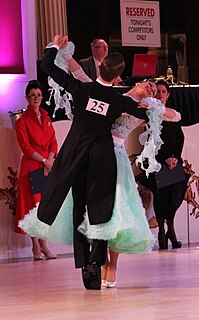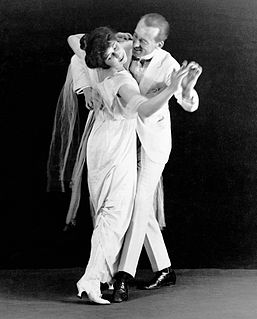
Ballroom dance is a set of partner dances, which are enjoyed both socially and competitively around the world, mostly because of its performance and entertainment aspects. Ballroom dancing is also widely enjoyed on stage, film, and television.
Ragtime – also spelled rag-time or rag time – is a musical style that enjoyed its peak popularity between 1895 and 1919. Its cardinal trait is its syncopated or "ragged" rhythm.

Scott Joplin was an African-American composer and pianist. Joplin achieved fame for his ragtime compositions and was dubbed the "King of Ragtime". During his brief career, he wrote over 100 original ragtime pieces, one ragtime ballet, and two operas. One of his first and most popular pieces, the "Maple Leaf Rag", became ragtime's first and most influential hit, and has been recognized as the archetypal rag.

"Alexander's Ragtime Band" is a Tin Pan Alley song by American composer Irving Berlin released in 1911 and is often inaccurately cited as his first global hit. Although not a traditional ragtime song, Berlin's jaunty melody nonetheless "sold a million copies of sheet music in 1911, then another million in 1912, and continued to sell for years afterward. It was the number one song from October 1911 through January 1912." The song might be regarded as a narrative sequel to "Alexander and His Clarinet", which Berlin wrote with Ted Snyder in 1910. The earlier song is mostly concerned with a reconciliation between an African-American musician named Alexander Adams and his flame Eliza Johnson, but also highlights Alexander's innovative musical style.

Roller skating is traveling on surfaces with roller skates. It is a recreational activity, a sport, and a form of transportation. Roller rinks and skate parks are built for roller skating, though it also takes place on streets, sidewalks, and bike paths.
The schottische is a partnered country dance that apparently originated in Bohemia. It was popular in Victorian era ballrooms as a part of the Bohemian folk-dance craze and left its traces in folk music of countries such as Argentina, Finland ("jenkka"), France, Italy, Norway ("reinlender"), Portugal and Brazil, Spain (chotis), Sweden, Denmark ("schottis"), Mexico, and the United States, among other nations. The schottische is considered by The Oxford Companion to Music to be a kind of slower polka, with continental-European origin.

Social dance is a category of dances that have a social function and context. Social dances are intended for participation rather than performance and can be led and followed with relative ease. They are often danced merely to socialise and for entertainment, though they may have ceremonial, competitive and erotic functions.

Novelty and fad dances are dances which are typically characterized by a short burst of popularity. Some of them may get longer-lasting life. They are also called dance fads or dance crazes.

Vernon and Irene Castle were a husband-and-wife team of ballroom dancers and dance teachers who appeared on Broadway and in silent films in the early 20th century. They are credited with reviving the popularity of modern dancing. Castle was a stage name: Vernon was born William Vernon Blyth in Norwich, Norfolk, England. Irene was born Irene Foote in New Rochelle, New York.
Rhumba, also known as ballroom rumba, is a genre of ballroom music and dance that appeared in the East Coast of the United States during the 1930s. It combined American big band music with Afro-Cuban rhythms, primarily the son cubano, but also conga and rumba. Although taking its name from the latter, ballroom rumba differs completely from Cuban rumba in both its music and its dance. Hence, authors prefer the Americanized spelling of the word (rhumba) to distinguish between them.

The New Leviathan Oriental Fox-Trot Orchestra is an American revival orchestra, that performs authentic orchestrations of vintage American popular music from the 1890s through the early 1930s. The orchestra plays particular attention to the music of New Orleans, Louisiana, where it is based. In addition to the well known compositions of jazz and ragtime composers like Jelly Roll Morton, Fletcher Henderson, and Eubie Blake, the orchestra's repertory includes the work of less well remembered New Orleans Tin Pan Alley composers such as Larry Buck, Joe Verges, Paul Sarebresole and Nick Clesi.
Kerry Mills(néFrederick Allen Mills; 1 February 1869 in Philadelphia – 5 December 1948 in Hawthorne, California), publishing also as F.A. Mills was an American ragtime composer and music publishing executive of popular music during the Tin Pan Alley era. His stylistically diverse music ranged from ragtime through cakewalk to marches. He was most prolific between 1895 and 1918.

James Reese Europe, sometimes known as Jim Europe, was an American ragtime and early jazz bandleader, arranger, and composer. He was the leading figure on the African Americans music scene of New York City in the 1910s. Eubie Blake called him the "Martin Luther King of music".
The bunny hug was a dancing style performed by young people, in the early 20th century. It is thought to have originated in San Francisco, California in the Barbary Coast dance halls along with the Texas Tommy, turkey trot, and grizzly bear.

The turkey trot was a dance made popular in the early 1900s. The Turkey Trot was done to fast ragtime music popular in the decade from 1900 to 1910 such as Scott Joplin's Maple Leaf Rag. Driven largely by youth counterculture of the time, the turkey trot fad quickly fell out of favor as the foxtrot, a much more conservative dance step based on the waltz, rose to popularity in 1914.

Dance music is music composed specifically to facilitate or accompany dancing. It can be either a whole musical piece or part of a larger musical arrangement. In terms of performance, the major categories are live dance music and recorded dance music. While there exist attestations of the combination of dance and music in ancient times, the earliest Western dance music that we can still reproduce with a degree of certainty are old fashioned dances. In the Baroque period, the major dance styles were noble court dances. In the classical music era, the minuet was frequently used as a third movement, although in this context it would not accompany any dancing. The waltz also arose later in the classical era. Both remained part of the romantic music period, which also saw the rise of various other nationalistic dance forms like the barcarolle, mazurka, ecossaise, ballade and polonaise.

Ernest Hogan was the first African-American entertainer to produce and star in a Broadway show and helped to popularize the musical genre of ragtime.

The original dance (OD) was one of the programs performed by figure skaters in ice dance competitions, in which the ice dancers skated "a dance of their own creation to dance music they have selected for the designated rhythm(s)". It was normally the second of three programs in the competition, sandwiched between the compulsory dance (CD) and the free dance (FD). The rhythm(s) and type of music required for the OD changed every season, and were selected by the International Skating Union (ISU) before the start of the season. The ice dancers were free to choose their own music and choreography and to create their own routines. They were judged on a set of required criteria, including skating skills and how well they interpreted the music and the rhythm.

Azonto is a dance and music genre from Ghana. Ghana News Agency cites their study which found out the dance is connected to the traditional Ga dance Kpanlogo, associated with the coastal towns in the country such as Chorkor, James Town, Teshie, Nungua and Tema, in the Greater Accra Region.
Wallie Herzer(néWalter Henry Herzer; 15 April 1885 San Francisco – 15 October 1961 Redwood City, California) was an American composer of popular music, music publisher, and pianist. Herzer flourished in music prior to and during World War I.













